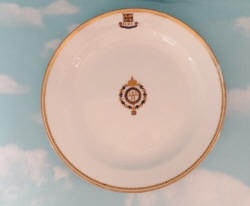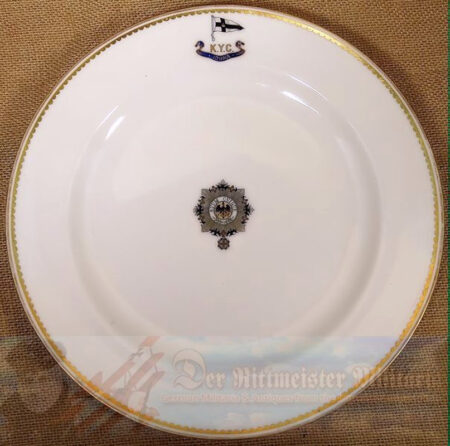Description
POCKET FLASK ATTRIBUTED TO KRONPRINZ WILHELM.
This is a consignment item. This is a superb example of a pocket flask and is attributed to Kronprinz Wilhelm of Germany. Kronprinz Wilhelm (1882-1951) was Kaiser Wilhelm II (1859-1941) and Kaiserin Auguste Viktoria’s (1858-1921) eldest son, and the heir to the German Empire’s throne. He became, instead, the “Kaiser who never was.” Kronprinz Wilhelm married Mecklenburg-Schwerin’s Duchess Cecilie (1886-1954) in 1905. As she was a beautiful woman, and the Kronprinz was an attractive man, the young pair was rivaled only by the younger Wilhelm’s parents as Imperial Germany’s most popular couple. Dozens of postcards were issued that featured them individually and together, many with their ever-growing family. [On a sad note, their eldest son, also a Wilhelm (1906-1940), was killed in France during WW II. His death caused the German military to pull all royals from front-line service. He had renounced his title when his Grandfather Wilhelm II tried to influence whom he could marry]. As were so many royals, young Kronprinz Wilhelm was trained for the military. In spite of the (presumed) circumspection such training might have encouraged, Kronprinz Wilhelm was a notorious womanizer. He and his wife eventually lived separate lives.
In August 1914 Kronprinz Wilhelm assumed command of the V. Armee, the principal army that eventually became involved in the Battle of Verdun. Both Germany and France committed about 1,250,000 troops to the battle, which officially ran from 21 February through 18 December 1916. French casualties ranged from 315,000 to 542,000 wounded, along with about 160,000 dead. German casualties ran from 281,000 to 434,000 wounded, with 143,000 battle deaths. [The carnage from this incredible ten-month bloodbath boggles the mind, particularly when multiplied by the hundreds of similar battles during WW I’s four grinding years]. Crown Prince Wilhelm eventually became commander of Army Group German Crown Prince in August 1916, but his service at the front took its toll. As the war progressed, Wilhelm became more vocal about the war’s senselessness. He served with the army through the war’s end in a reduced capacity. At the war’s end, Kronprinz Wilhelm signed letters of abdication along with his father. Both men then went into exile in the Netherlands. While the Kronprinz returned to Germany in 1923, his Father remained in the Netherlands until his 1941 death. Although the Kronprinz was hopeful that the monarchy might resume, he eventually realized that his dream would not come to pass. He withdrew to private life in the late 1930’s, living out his days to die quietly in 1951.
Today we are offering a rather unique pocket/hip flask attributed to the Kronprinz. Although Kaiser Wilhelm II was known for his generosity in giving out personal gifts, those from the Kronprinz were not as common. My personal theory is that this flask was NOT a gift, but one used personally by the Kronprinz. His gifts to others tended to be more modest than those given out by Wilhelm II. [Although we do offer one of the young Kronprinz’s more lavish gifts: a marvelous silver frame (see immediately below this entry)].
I would like to emphasize that Kronprinz Wilhelm’s personal ownership of the flask is JUST a theory. If it was not his personal possession, it was a magnificent gift to a very favored man. It definitely was a man’s gift as it is quite large and impressive. The flask certainly was NOT dainty enough to have been used by a lady. It measures 6 ¼” in length and 4 ½” in width. Its back is slightly curved, so it could snuggle up against the owner’s hip. A further indication of its size shows that it holds 12 ounces of liquid. It would have been perfect for storing either brandy or schnapps, both of which were equally prized by Imperial German males.
Its obverse features the Kronprinz’s large (a substantial 1 ¼” x 2 ¼”) royal cypher in its center beneath a Hohenzollern Crown. The cypher itself is made of high-quality cobalt-blue enamel overlaying an intricate silver scrollwork design accented by several stylized leaves. The flask’s reverse sports an unadorned, mirrored surface.
A unique flip-off stopper at the flask’s top swings away to allow one access to its contents. A series of hallmarks appears under the swing away stopper. The crown and half moon (mandated in 1885 by Kaiser Wilhelm I for silver content) appears on one panel, along with a boxed .800. Another box to the .800’s right features a castle, followed by “R 9795” and “22” on that same panel. Another panel features an additional “22.”
This is a surprisingly well made, high-quality flask that might have belonged to Kronprinz Wilhelm.










